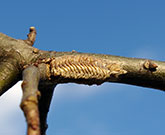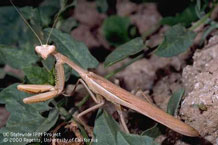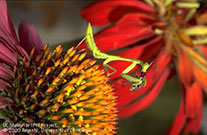home | fall garden | japanese maple garden
Praying Mantis
Praying mantis gets its name because of the "prayer-like" stance in which it is commonly observed. There are over 20 species of praying mantis that are native to the United States. Praying mantises are exclusively predatory. Insects form their primary diet, but larger species have been known to prey on small scorpions, lizards, frogs, birds, even mice. Their prey are caught and held securely with spiked forelegs. Praying mantises protect themselves by camouflage and concealment in order to avoid predators and to better snare their prey. Some species have evolved to not only blend in with foliage, but to mimic it appearing as either living or withered leaves, sticks, blades of grass, and even tree bark. Praying mantis goes through three stages of transformation: egg, nymph, and adult. The female lays 10 to 40 eggs in a frothy mass. This froth then hardens, creating a protective coat around the eggs. Once hatched, nymphs begin to feed. Nymphs and adults are structurally quite similar, except that the nymph is smaller and has no wings. The natural lifespan of a praying mantis is about 10 to 12 months. Praying mantises are able to live this long because they have defense mechanisms that help aid in their survival. Their famous forelegs are very powerful for their size and can crush its prey in half. Their mouth parts have several strong cutting components to tear and consume through insect exteriors. Praying mantises are able to turn their heads 180° for excellent vision and hearing.
 |
 |
 |
 |
 |
